Figueras and Dalí
last update: 21 May 2021
This travel report was first written in spring 2009 when we visited Figueras, in the province of Girona in Spain. As such it describes what we saw in 2009, and things might well have changed since then. For example, you can now take a virtual tour of the museum. This is a travel report, so I do not enter into a discussion on the complex relationship Dalí had with Gala, nor do I include paintings, etc. that are not found in the museum. We have also a separate webpage dedicated to the Dalí·Jewels collection which is just next door.
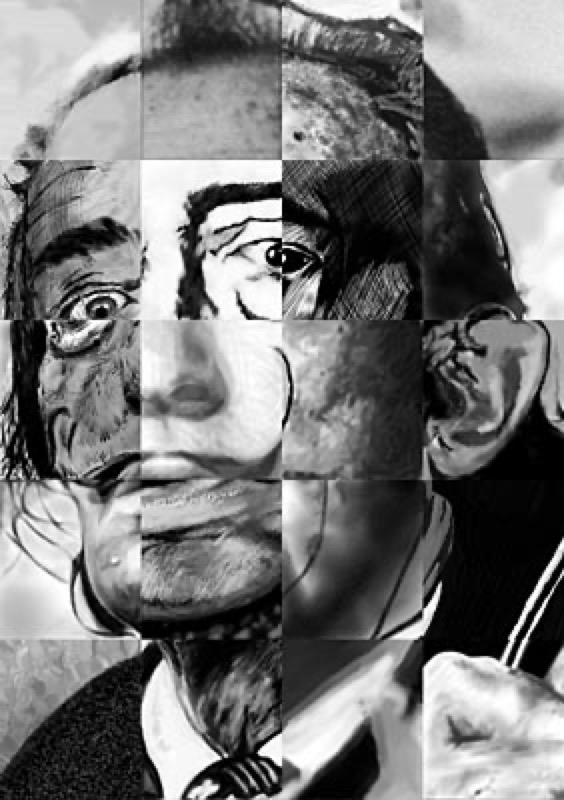
"At the age of six I wanted to be a cook.
At seven I wanted to be Napoleon.
And my ambition has been growing steadily ever since"
The Spanish Catalan Surrealist painter Salvador Domingo Felipe Jacinto Dalí I Domènech, 1st Marqués de Dalí de Púbol, was born in Figueras in 1904 and died nearby in 1989. He is actually buried in a crypt under the stage of his Theatre-Musuem in Figueres.
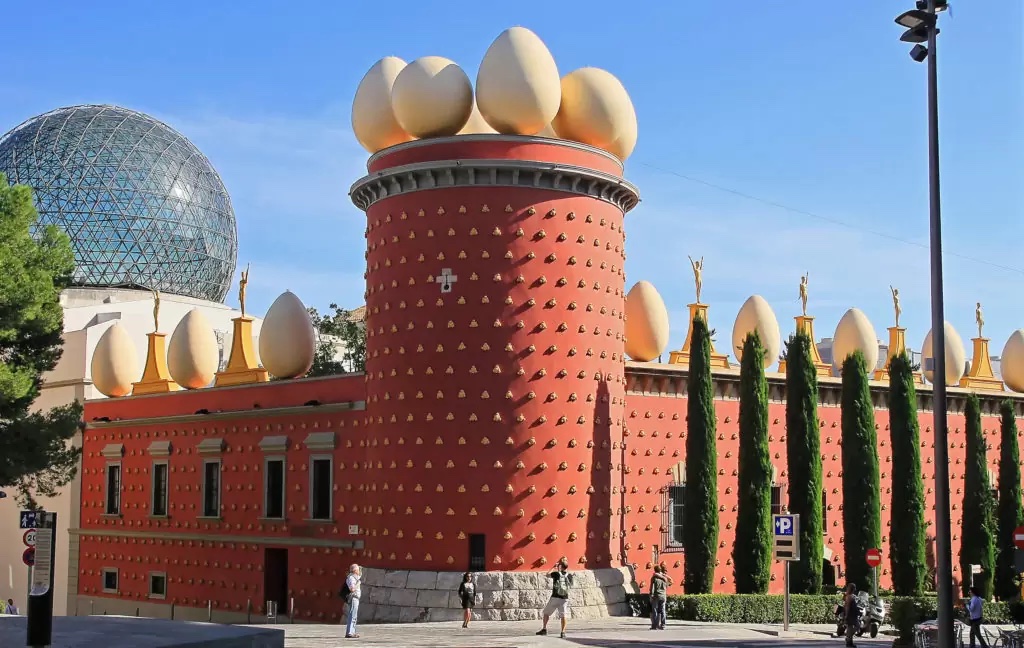
Our destination was in fact the Theatre-Musuem in Figueres. The full name is "Treatre-Museu Gala Salvador Dalí", and references Gala, his wife and life-long muse. Here we can see the so-called Torre Galatea, re-named after Dalí deceased wife, and where he then lived from 1983 until his death in 1989. Crimson and yellow, are the colours of the Catalan flag.
Originally the building was a theatre when Dalí was a child, and he had his first exhibition in the lobby at the age of 15. So a precocious, but spoilt, child (Dalí readily admitted he was totally spoilt by his parents). Dalí once said "I started calling myself a genius to impress people, and ended up being one".
After the theatre was bombed during the Spanish Civil War, it was rebuilt by Dalí as a museum dedicated to his art. Today it houses the single largest and most diverse collection of works by the artist. In fact I understand that Dalí called the museum the largest surrealist object in the world.
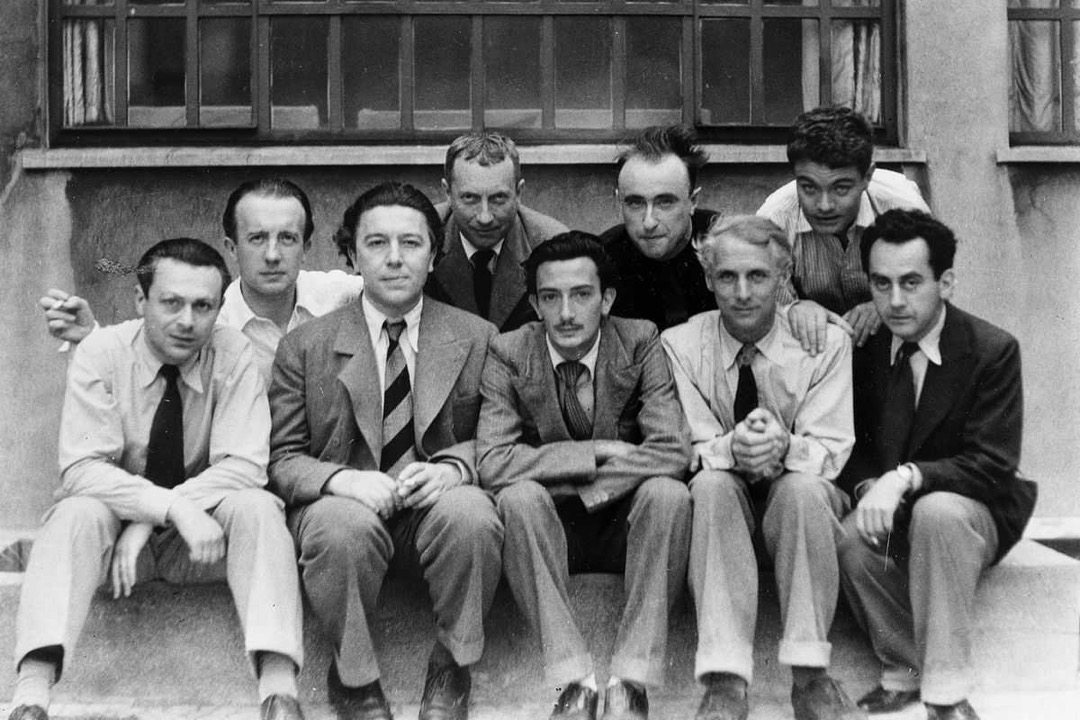
Above we have some of the most important surrealists active in Paris in 1933. From left to right: Tristan Tzara, Paul Éluard, André Breton, Hans Arp, Salvador Dalí, Yves Tanguy, Max Ernst, René Crevel and Man Ray.
Dalí is probably the best known Surrealist painter of the 20th century. Originally he was hailed as a talented genius and presented as the "poster boy" for Surrealism, but later he was shunned as being too eccentric and self-absorbed. As Dalí once said "The thermometer of success is merely the jealousy of the malcontents".

"We are all hungry and thirsty for concrete images.
Abstract art will have been good for one thing: to restore its exact virginity to figurative art"
When the museum first opened in September 1974 it rapidly became very popular, but was said to have been less a museum and more a form of "organised chaos". Today the museum remains popular, but it is now well organised and easy to visit. However, we should always remember that Dalí wrote…
"Everyone should consider the museum as a work of art in itself, …
full of information, but totally devoid of exhaustive explanations"
I don't remember there being a particular route plan for the visit, and Dalí is quoted as saying "there are those who don't need a description, and those who aren't worth a description". In fact initially the works were displayed without their titles. He wanted it not to be a simple exhibition, but a place where people's perceptions where challenged and, hopefully, modified.
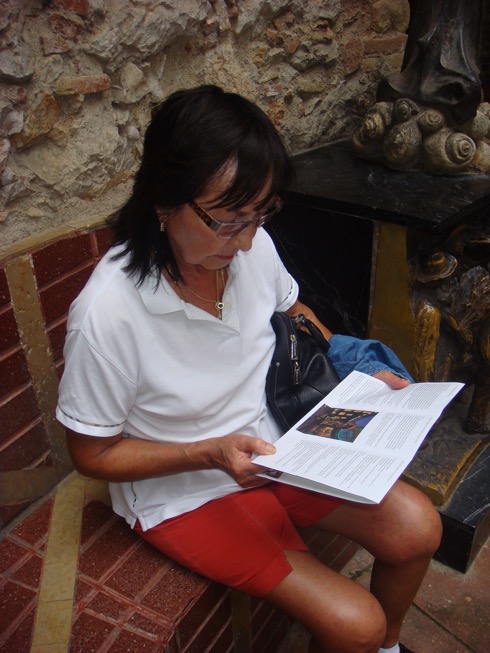
Dalí had Gala, and I have my wife, who we can see above is trying to decide if it's worthwhile following the museum guide or not. Finally the easiest way was to walk around, and hope to find the odd clue in the guide afterwards.
Dalí was proud to be Catalan, but he was also proud to be Spanish. The Catalans are reputed to believe only in the existence of things they can eat, hear, feel, smell or see. Dalí made no secret of this materialistic and culinary atavism, "I know what I'm eating. I don't know what I'm doing", and in later life he loved to say "Christ is like cheese, a whole mountain range of cheese". It is reported that his "soft watches" were inspired by runny Camembert. Dalí was often accused of loving money, and he was perfectly honest when he wrote "Man is an alchemical substance meant for the making of gold".
Dalí is seen by the general public as a Surrealist painter, but it would be a mistake to "pigeon hole" him with a strict label. In reading through this visit report it's important to keep an open mind about how Dalí saw himself as an artist.

The painting above called "Cadaqués from the Back" was painted when he was 17, and the painting below is a "Cubist Self-Portrait" painted when he was 19 year old.
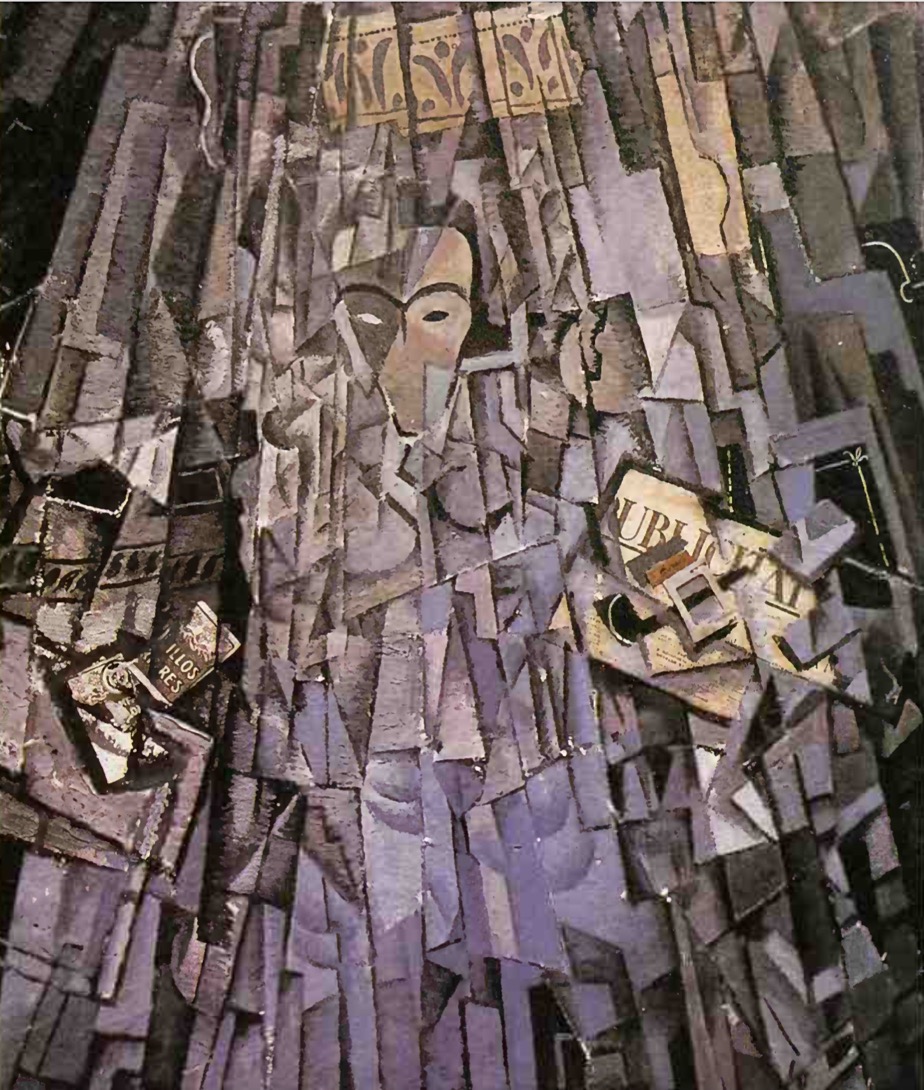
The Exterior
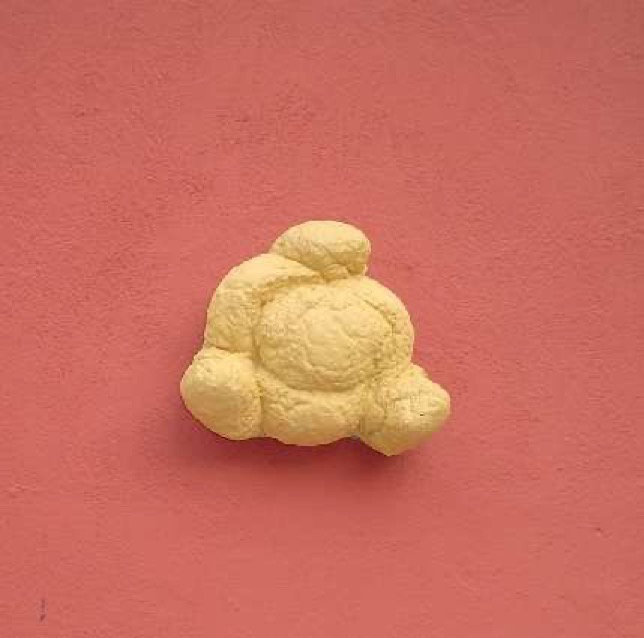
In the photograph of the museum exterior walls we could see they were encrusted with small golden yellow concrete "blobs". They are in fact life-size casts of loaves of Catalan bread, or more specifically "pa de crostons", the three-cornered bread of Figueres, Dalí's home town. Bread figures often in Dalí's sculptures, and he said himself "Bread has been one of the oldest subjects of fetishism and obsessions in my work, the number one. The one to which I have been most faithful".
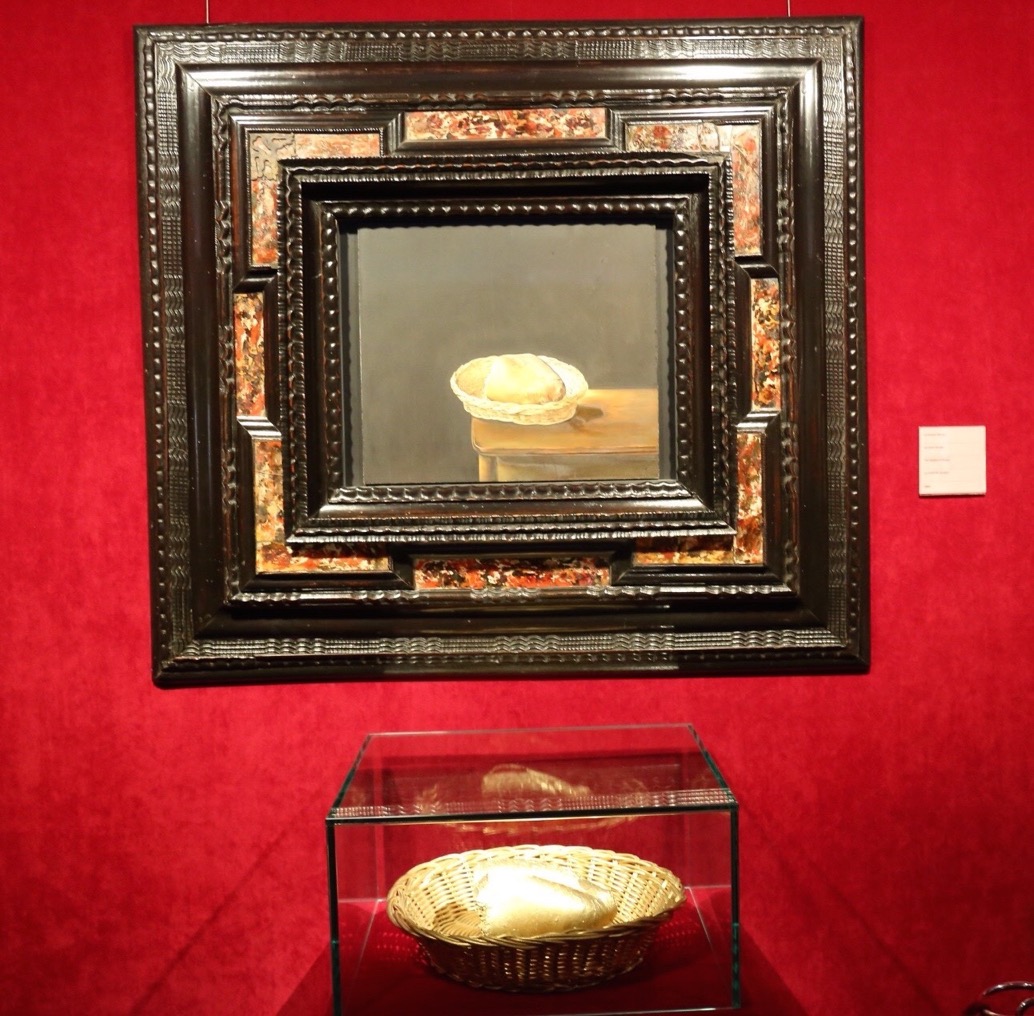
In fact in one small area of the museum there is painting of Dalí entitled "Basket of Bread". It hangs above a golden sculpture of a loaf sitting in a real bread basket. The painting is in an ornate jewel-box style frame, and the ensemble sits behind a velvet rope. All designed convey the importance of something as simple a 'bread'.
Everything Dalí did had some symbolic importance. So we must remember that bread was of course the symbol of Christ's body, and hence his sacrifice and resurrection. Equally bread is in many ways the symbol of mans evolution from a hunter-gatherer to a settler, and is thus present in almost every religion. However it is quite possible that the message might be somewhat simpler, is not bread the ultimate symbol of man's survival on Earth.
The so-called "Catalogue Raisonné" of all Salvador Dalí's paintings can be found here. There is also a webpage dedicated to the vocabulary of Dalí, including the different symbols that illuminated his life.
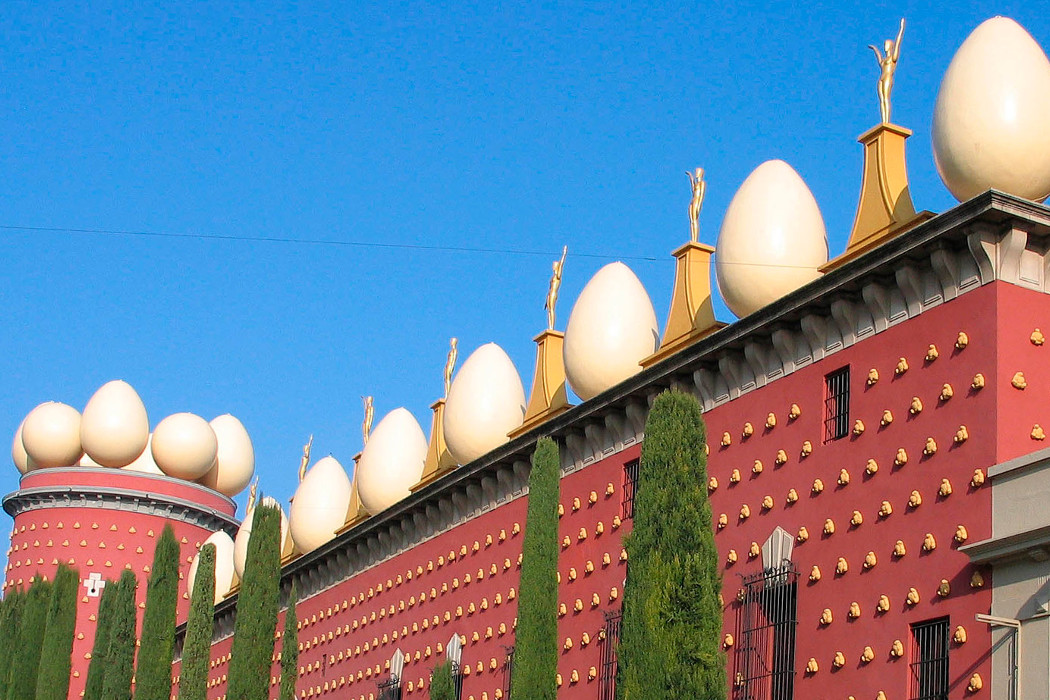
On top of the walls are dinosaur-sized white eggs, yet another symbol. Associated with the beginning of life, eggs are a symbol of creation, and are strongly associated with revival and rebirth, and in particular the Christian concept of resurrection. In addition, apparently big eggs symbolise virgin birth.
At least according to some experts Dalí was intrigued with an egg hanging in the painting "Madonna and Child with Saints" by Piero dell Francesca (dated to 1472-74). It is said that Dalí considered the existing of this egg as one of the greatest mysteries in the paintings of the Renaissance period. The lower part of the painting is often presented, along with a discussion of the clothes, jewellery, armour, etc. of the Virgin, the sleeping Child, the condottiero Federico da Montefeltro, and the surrounding host of angels and saints. However almost half the entire painting is actually made up of an apse with a shell semi-dome from which hangs an ostrich egg.
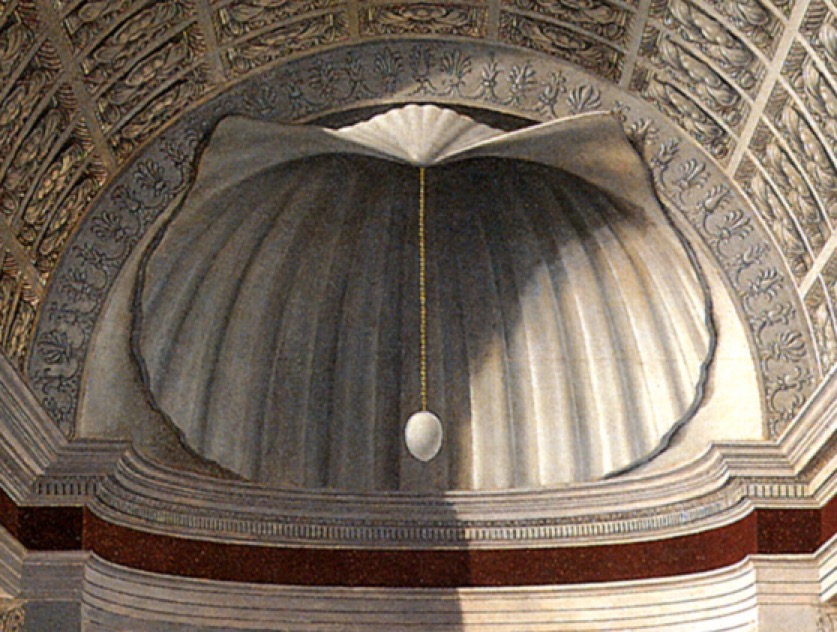
The shell was the symbol of the new Venus, Mary, and of her eternal beauty. The egg was the symbol of the Creation, and in this painting the egg hovers over the baby Christ. In Christian tradition the ostrich egg is a symbol of the resurrection, the breaking open of the tomb, and thus of 'virgin births'. In fact eggs can be found hanging over alters dedicated to the Virgin. In medieval myth the larger ostrich egg was supposed to hatch in the sunlight without intervention, and thus it became a symbol of virgin birth. The analysis of this wonderful painting continues when the experts compare the perfect oval of the egg hanging just over the perfect oval face of the Virgin,… but back to Dalí. For him, the Virgin Mary, translated of course into Gala. Madonnas begin to appear in Dalí's work in 1943, and the Virgin Mary was usually modelled by his wife and muse, Gala.
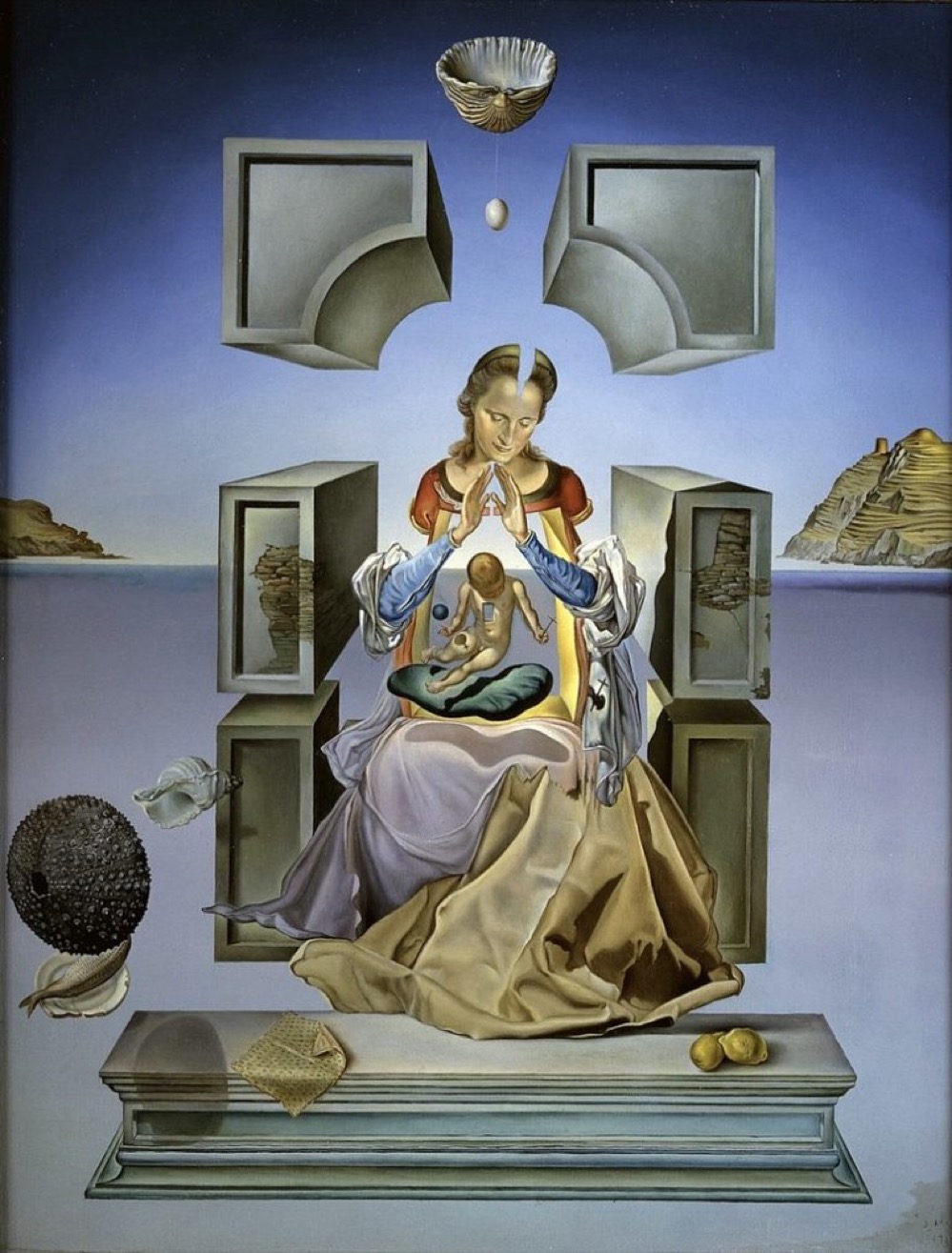
Above we have Dalí's "The Madonna of Port Lligat", his specific take on Mary holding baby Jesus in her lap. It is broadly looking forward to Easter, the Crucifixion and the birth of new life. And naturally it is particularly personal in that it is based around Dalí's wife, Gala (Port Lligat is a small costal village where Dalí lived). There are in fact two different versions of this painting, one in America and one in Japan. This is the smaller 'American' version dating from 1949, and the larger, but somewhat different version, dates from 1950. We can see again the shell and ostrich egg, symbols of purity and virgin birth. As I understand it, this painting corresponded to Dalí's new enthusiasm for the Catholic Church, and in 1949 he was granted an audience with Pope Pius XII. According to one source this was Dalí's first "religious painting", and he actually presented it to the Pope for his approval, which was granted.

In 1982 Dalí resurrected the egg in his painting entitled "Detás de la ventana, a man izquierda, de donde sale un cuchara, Velázquez agoniza" (Velázquez Dying behind the Window on the Left Side out of Which a Spoon Projects). It is based upon "The Portrait of Sebastián de Morra" by Velázquez set against the Courtyard of El Escorial. I leave it as an exercise for the reader to unfold the exact symbolism in this particular painting. However, some experts feel that it symbolises death, probably his own (he died in 1989). His life and death is supposed to be represented by the sinuous golden line that starts in one of the windows of building in background. The torn pieces of paper are said to represent death, and the fried eggs now appear to represent instability. Dalí picked Sebastián de Morra because he claimed that his eyes showed more intelligence that anyone else in the Velázquez paintings of the Spanish court.
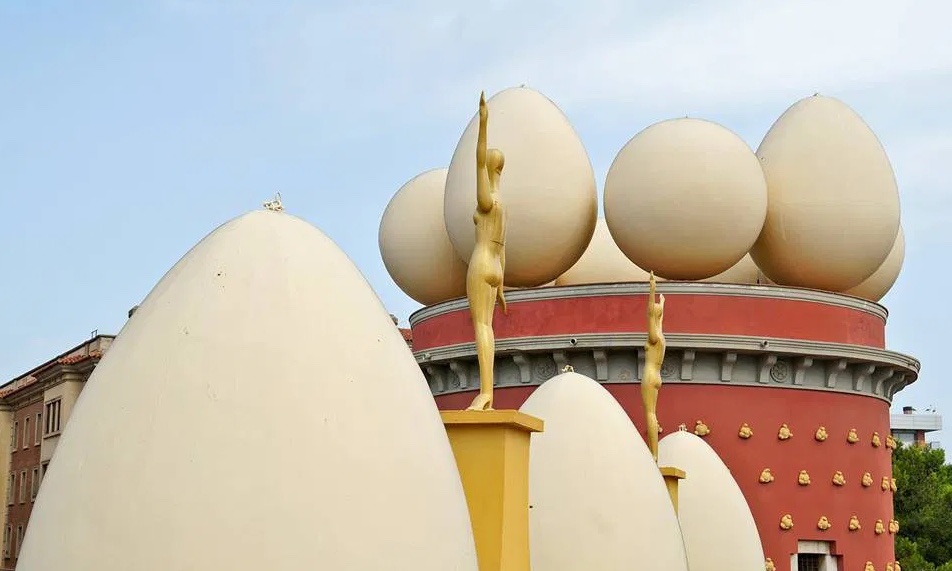
The final touch on the roofline are the golden Oscar-like mannequins, which some say represent wealth and fame, and others see them as spectators watching over the great work of Dalí. So perhaps they represent wealthy and famous spectators, three things Dalí yearned for (money, fame and celebrity).
The Entrance Façade and the Placa Gala-Salvador Dalí

Let us move to the main entrance of the Theatre-Musuem, situated in what is now called "Placa Gala-Salvador Dalí". The story goes that it all began in 1961. The town of Figueres paid tribute to Dalí by presenting him with its highest distinction, a fig leaf, and putting on a bullfight in honour of Dalí's surrealist bullfight. He built an enormous bull of plaster covered in gold-coloured plates which had rockets and flares coming out of its body. As it disintegrated it spurted out a red liquid, and finally a white dove.

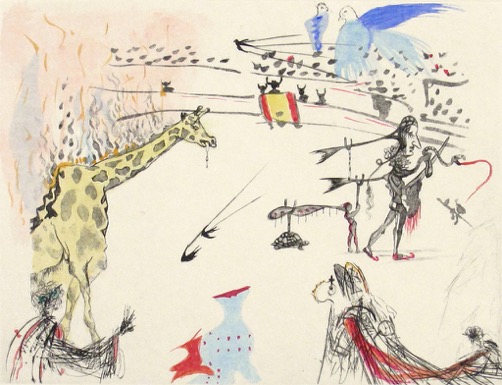
Below we can see Dalí with Marcel Duchamp attending the bullfight.
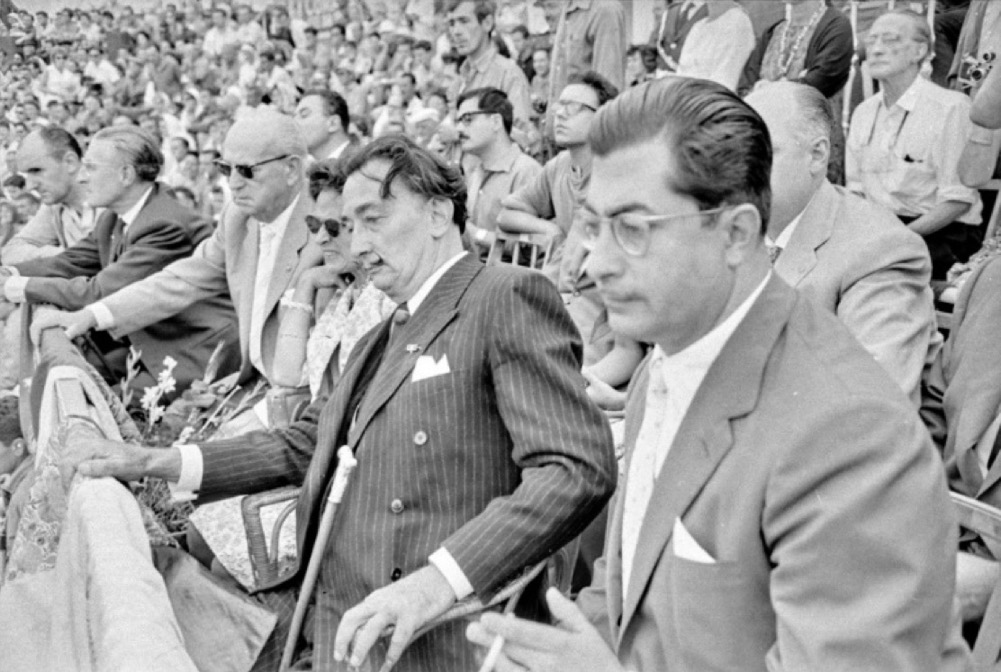
In the early 1960's the mayor of Figueres then ask Dalí to donate a work for the Museu de l'Empordà, and Dalí replied that he would donate an entire museum. The Municipal Theatre had been destroyed in a fire during the Spanish Civil War, and the building was in a very poor state. The ceiling of the orchestra pit had collapsed, the boxes were destroyed with only the access corridors remaining, and only the arch of the stage was still visible. The entrance hall and restrooms were the only part to survive relatively intact. It took 10 years, but it is said that Dalí designed every detail of the restoration, through to the official inauguration in September 1974. Today the museum consists of the refurbished theatre, a number of extensions, and the jewellery exhibition rooms.

Sitting in the front square is the Monument to Francesc Pujols. Francesc Pujols (1882-1962) was a Catalan writer and philosopher. Dalí spent some time with him, and in 1974 published a book of their conversations. His monument to Pujols was erected in 1975.
The monument is an amalgam of pieces representing a figure holding with his hand a golden egg at the top. The base consists of a hundred-year-old olive tree trunk and the body, surrounded by a kind of white cloth, is made up of a set of pieces. In the middle is a relief with people from various trades. In front there are two busts: the one below is that of the Roman emperor Antoninus Pius from the 1st century AD, above this head is the bronze bust of the philosopher Francesc Pujols, by Joan Borrell i Nicolau (1888-1951). At the back of the figure is another stone bust. A representation of the hydrogen atom hangs from a higher pole. A grille closes the set.
Intellectual history is the study of the history of human thought, and how intellectuals concerned themselves with ideas. Through the 20th century it strived to settle itself as a respectable academic field. The field evolved as a mixture of acute cultural reflections, sharp political criticism, philosophical analysis, but was often contested as not being founded on a legitimate academic approach to culture and thought. In simple terms it made empirical claims that could almost never be verified. However, after WW II, the need for an interdisciplinary "philosophy of history" emerged which would build on existing philosophical traditions, and could be used to define methods, trends, and boundaries of the field as an academic discipline. It worked, but in the 1960's the main charge against the discipline was that it was irrelevant. It all appeared to boil down to language and context, i.e. understanding intention in a series of core texts or writers. The discipline produced erudite and insightful analyses, but not really distinct from any historian working at the time. However, by the 1990's intellectual historians were showing that past texts were not so black and white, and emphatic historical arguments were often not supported because of textual complexities or inconsistencies. Some experts claimed that we understood better early Renaissance states than, say, the emergence of 20th century nationalism. Establishing "facts" turns out to be a complex intellectual task to unfold past events, understand what was planned, and finally what courses of action were taken and why.
It is against this backdrop that the question about "Catalan Intellectual History" emerged, and the idea that to study Catalan intellectual history was a "suicidal vocation". In the 21st century many Spanish regional thinkers have been published and re-published. However this has proven more difficult for thinkers under the dictatorship of Primo de Rivera, the Second Spanish Republic, and early Francoism. It is sufficient here to note that a strong link appears to have existed between the modernist architecture of Gaudí, Pujols' "hyparxiology" in the 1920's, and the way Salvador Dalí made his attempt to construct an aesthetic view on Catalan identity.
In fact Dalí looked to Pujols as having proved the existence of a genuinely Catalan philosophical current first established by Ramon Llull (1232-1316), and to have formatted a "general concept of Catalan science". Pujols became Dalí's greatest intellectual referent and "North Star". Dalí spoke of Pujols' statue as being a form inseparable from mind and matter. "It's body is formed from an ancient olive tree with a twisted trunk, like entrails or like the dragons that guard the underworld. The breast of the sculpture is outlined by little figures in relief representing the men of the people. And protruding as its heart - a heart out in the open - we see the head of a Roman patrician. Above it is that of the Emporda philosophising Francesc Pujols".
The admiration between Dalí and Pujols was mutual, through Dalí Pujols saw his predictions fulfilled about the triumph of Catalan painting in the world. He wrote an article in which he described Dalí as the savour of modern art, "whose genius assures that he will mark an hour on the clock of the Palace of Art".
Some experts have characterised Dalí as "bipolar", in that on the one hand he followed the philosophical-scientific theories of Pujols, and on the other hand he kind of "controlled" the insanity that was brought on by his immersion in surrealism. Others talk of Dalí as being "outside of time", or being a simple and shy man, eager for knowledge, but hiding himself behind his character.
One interesting analysis noted that Dalí was one of the first artists to observe that brushes and fabrics were no longer the only weapons a painter could count on - there was also the movie camera. Dalí's artistic superiority with respect to the seventh art, however, led him to the most absolute failure. Once he had worked on the cinematographic demands of figures like Buñuel in Spain, or Walt Disney and Hitchkock in the United States, his projects were reduced, almost by magic, to the minimum expression and to some almost imperceptible sets. Faced with this disappointment, Dalí realised that in order to succeed he needed to strategically modify his position with respect to the cameras. He had to get in front of the lens, be the actor, overcoming his sickly shyness and, above all, develop the ability to communicate. Dalí thought that he would be the first artist capable of painting what his eyes see inside his brain, and of capturing what was hidden in the left hemisphere, as if he was using a camera. Dalí conceived wealth and glamour as a formula for popular enthusiasm and, for this reason, he turned to the cinema, which was the art that made "international celebrities". He soon realised the importance that advertising in the United States gave to so-called mad-artists. And so Dalí became the inventor of the artist-show (showman), creating a school faithfully followed by figures like Andy Warhol.
The problem is that the Dalí myth comes from an obfuscation of his production methods. Political cowardice, unconventional sexual orientation, the image of the crazy artist disguised as a clown ... all this resulted in forgetting the artistic importance of Dalí. In short, Dalí possessed artistic virtues, such as a expanded visual acuity, the application of the scientific method to pictorial creation, attention to new technologies, a "magnetic impulse towards nuclear mysticism", and the reorientation of modern painting in the Baroque or Renaissance style. Dalí admired the Goya mastery of the dream, and his favourite phrase was always the well-known aphorism "the dream of reason produces monsters", which was placed in parallel with the avant-garde idea that pure creation only created monsters. He also admired the period in which the Aragonese artist made man more carnal, more sexual. Dalí painted hallucinations and was interested in the grotesque, in seascapes with a flat horizon where there was a strange object. Or by humanoid creatures with distorted anatomy, and monstrous objects part human, part primeval flesh, where sexuality turned the human into an animal. In short, tumescent bodies, united couples, metamorphosis.
That was pretty intense for an introduction, but I wanted to try to touch on a few elements that might help when entering the museum and viewing one or other of Dalí's paintings.

Before we go though into the vestibule, we will return for a moment to Dalí's almost lighthearted preoccupation with bread. If you look carefully at the façade you can see many figures "wearing" a loaf of bread on their heads.
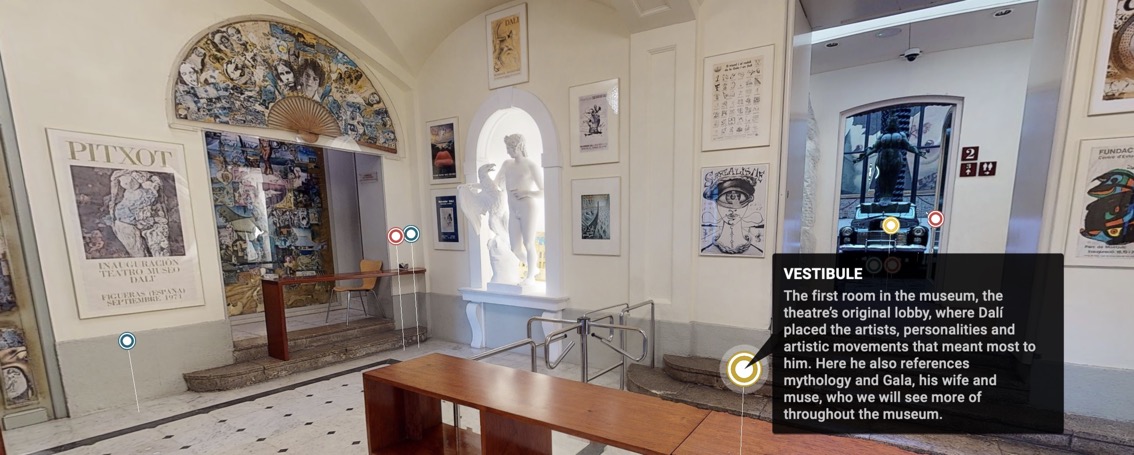
I'm going to be using screens captured from the virtual visit to navigate inside the museum.
The Courtyard
Where to start? With the courtyard as it is today, or as it was in 1964? We will start with it as we see it today.
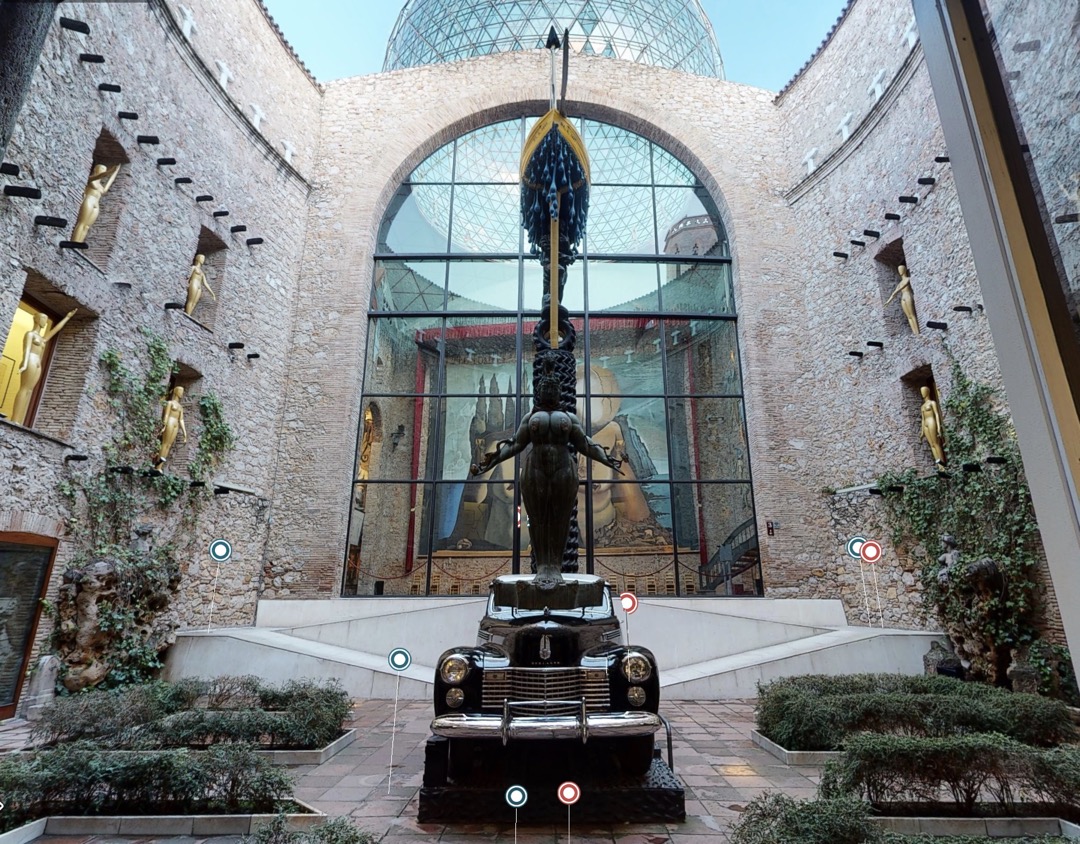
Now here we are walking into the courtyard (Pati de Butagues) and right in front of us is the "Rainy Taxi".
What comes to mind? Maybe nothing, or maybe the eternal question "why is it always more difficult to find a taxi when it's raining?". Dalí's "Rainy Taxi" has nothing to do with either, because it is directly linked to the Exposition Internationale du Surréalisme held in Paris in 1938. André Breton and Paul Éluard were the organisers, Marcel Duchamp was the "générateur arbitre", and Max Ernst and Salvador Dalí were special advisors. Dalí contributed six paintings and the "Rainy Taxi".

Dalí's "Rainy Taxi", a former taxi, welcomed the visitors in the forecourt. The old automobile was covered with ivy inside and out, and a female dummy with dishevelled hair and dressed in an evening gown sat between some heads of lettuce and chicory in the back of the car. Next to her was a sewing machine. The driver was a doll, whose head was framed by the mouth of a shark and whose eyes were covered by a pair of dark glasses. The interior was constantly sprayed with water so that the clothes of the lady were drenched and the blond wig dissolved into felted strands, while some edible snails, visible on the lady's neck, left their slimy traces.
On the 6 November 1974 a crane lifted an old car into the middle of what was still an old pit, fully restored but empty. The car was the Cadillac that Dalí and Gala had used in America during their uninterrupted stay between 1940 and 1948. At the time of our visit, I understood that the Cadillac on show was in fact the 4th reproduction.
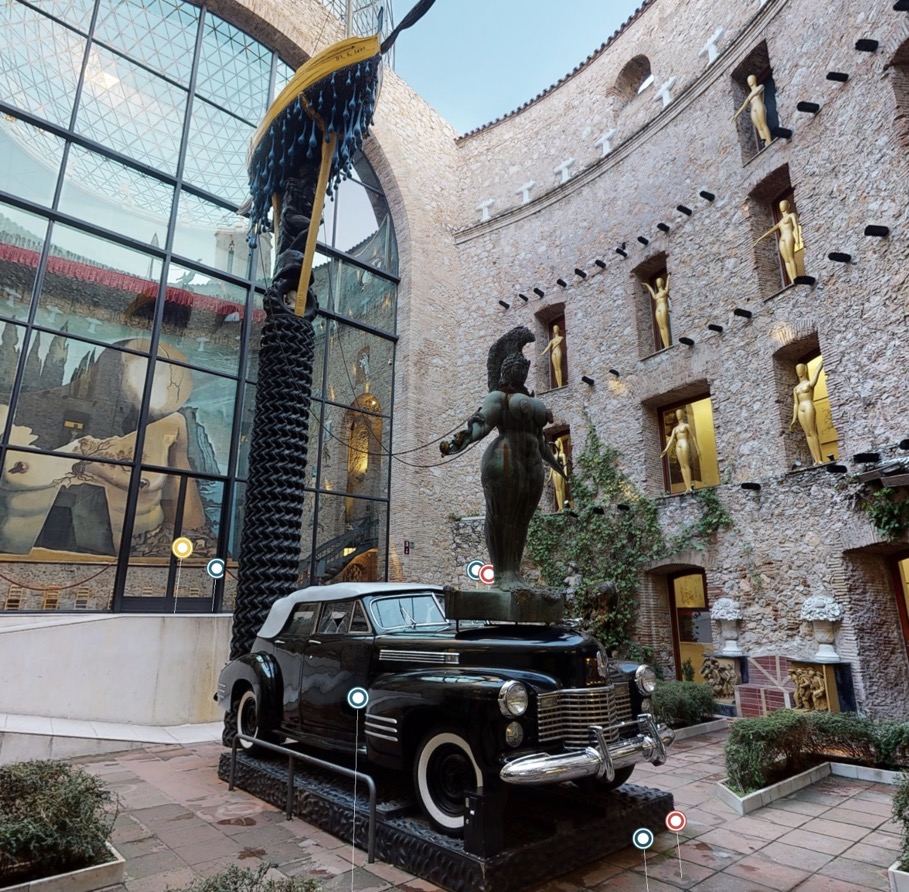
Sitting on the bonnet is the 260 cm tall bronze Queen Esther by Ernst Fuchs, one of the founders of the Vienna School of Fantastic Realism. Fuchs's style was considered a mixture between Surrealism, Symbolism and figurative tradition, with a strong religious and mystical presence. He has often been called the "German Dalí", and when he saw the works of Dalí in 1947 Fuchs decided to adopt the same focus on precision drawing. By chance they met in 1951, and became firm friends. Fuchs also defended Dalí and his view that art was a business. Fuchs wrote "He [Dalí] was a very sweet person. Everyone saw him as an eccentric, but being an eccentric myself, I saw him differently. All his extravagances weren't extraordinary at all. The only different is that he didn't hide them".
Behind we can see kind of "Trajan's Column" of old car tires on which is set the small boat that Dalí and Gala used to go sailing in from Port Lligat. As we look around the walls we can see more Art-Deco style golden-Oscar spectators standing in the different entrances that would have provided access to the theatre boxes. They all have their arms in different positions, and are welcoming visitors into the museum. Framing the entrance to the area there are two original street lamps made by Hector Guimard for the Paris metro, and they sit on supports of fossilised snails from the Pyrenees. On the walls there are Dalí's "Grotesque Monsters" from 1975 made from gargoyles taken from the church of Sant Pere de Figueres to which Dalí added branches, old furniture, etc. He always said that he never worked by selection, but always by accumulation, and this is a good example.
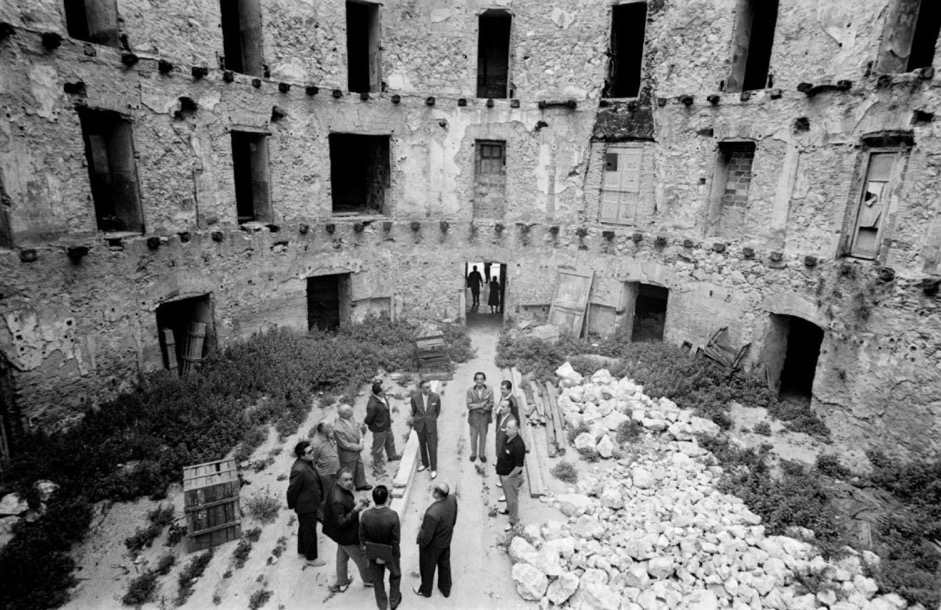
Before we move on, let's just remember what this space was really like when Dalí decided to "restore" the building. Above we can see what Dalí "inherited", and below we can see them lifting the first Cadillac into place.

Dalí always said that his museum was a "readymade". Just as Duchamp "transformed" ordinary objects into works of art, so Dalí considered his theatre already a work of art, even before it contained a single work of art.
Back to the question "why is it always more difficult to find a taxi when it's raining?". The obvious answer is that rainy weather increases demand for taxi rides and there is no rapid response system to put more taxis on the road when it rains. Classical economists would even expect taxi drivers to work longer hours to profit "while the sun shines" (joke). The truth is something totally different. It appears that taxi drivers are "target earners", i.e. they drive until they hit a set daily income target. Rainy weather means that they hit their daily target income sooner, and they then quit and go home.
The Cupola

The "pati interior" is the former stage of the old theatre, and it is in many ways the heart of Dalí's idea of the visitor participating in a theatrical dream. In fact he wrote "I want my museum to be like a single block, a labyrinth, a great surrealist object. It will be a totally theatrical museum. The people who come to see it will leave with the sensation of having had a theatrical dream". Someone called this idea of a museum the "Cave of Dalí Baba".

Today the stage is covered with a geodesic dome designed by the Spanish architect Emilio Pérez Piñero. On the far wall is the "Labyrinth" a 8.8 by 13 metre canvas theatre backdrop used in a ballet of the same name. It was used in the Metropolitan Opera House in New York in 1941.

High on the left we can just make out a large painting with the highly evocative title of "Gala desnuda mirando el mar que a 18 metros aparece el presidente Lincoln" (Gala Nude Looking at the Sea Which at 18 Metres Appears the President Lincoln). And in fact standing on the stairs on the right-hand side of the room we can see appear Lincoln.

The Treasure Room
The "Treasure Room" is through the small doorway on the left, and is said to be Dalí's "jewellery box" where he kept his most prized possessions.
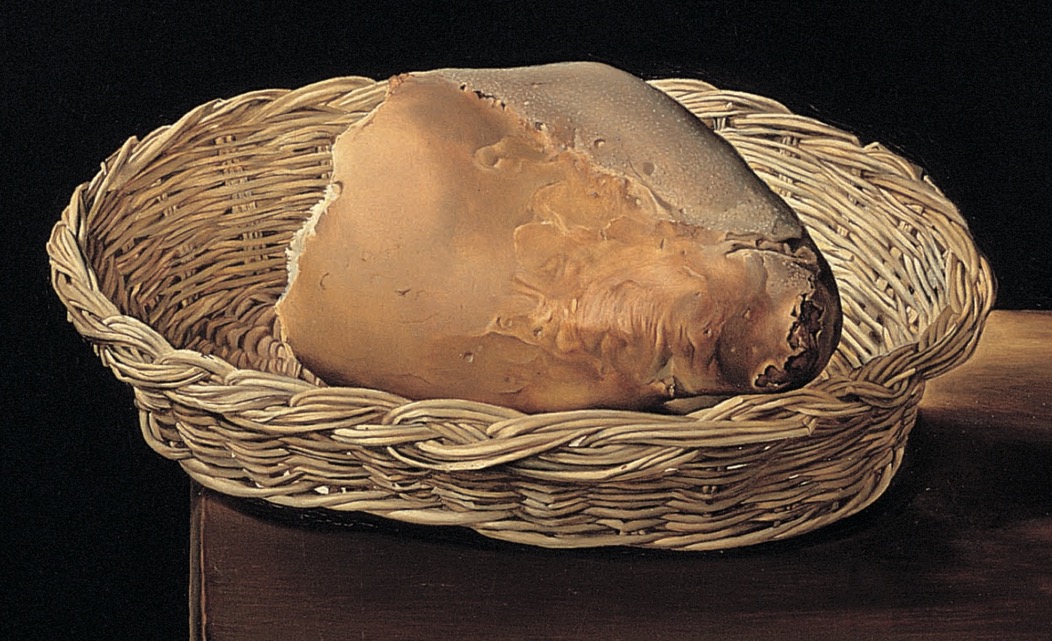
Taking pride of place is the "Basket of Bread", which I already mentioned in the introduction.
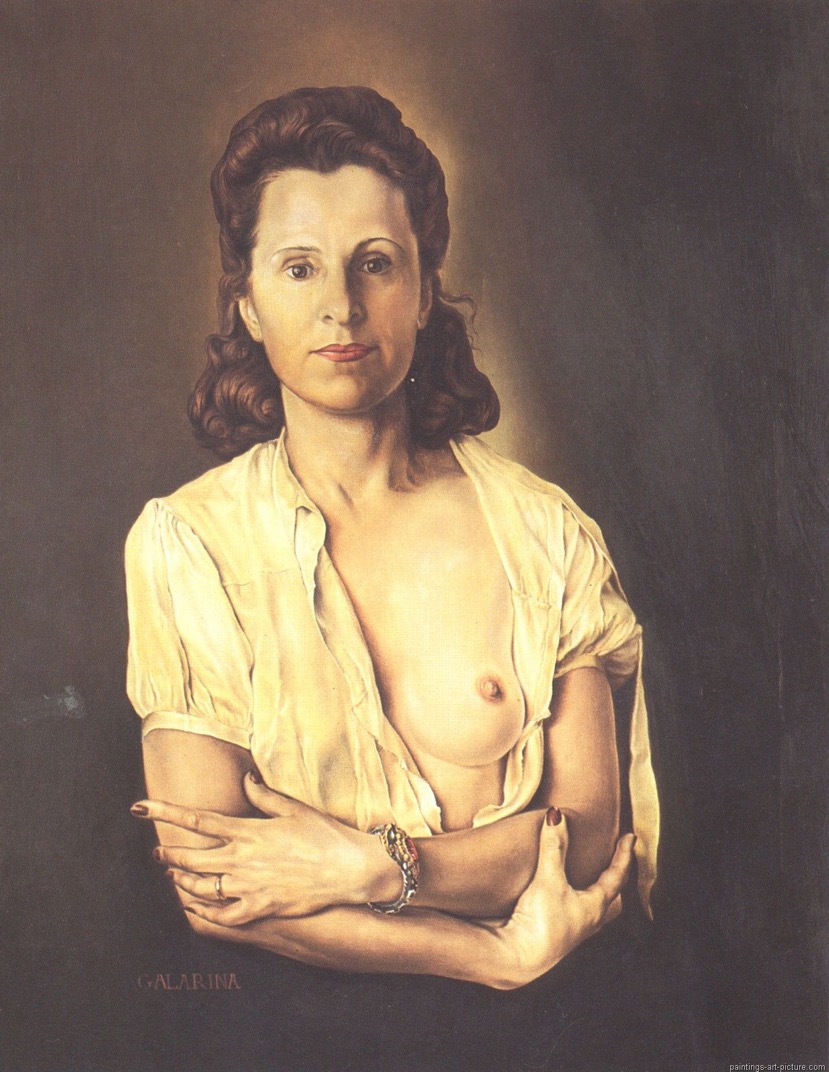
And you will not be surprised to know that it is also home to portraits of Gala, such as "Galarina" (above) and "Leda Atomica" (below).

Much has been written about this second "portrait", and in particular on the symbolism involved, e.g. Leda and the Swan. After the use of the atomic bomb, Dalí decided that the modern age had to be assimilated into art if art was to be truly contemporary. Just as atomic particles don't touch each other, so here Dalí suspends everything and leaves all the different components unconnected. The composition took three months to compose in that Dalí performed complicated theoretical calculations helped (or performed) by Prince Matila Ghyka. The basic idea is based upon Pythagorean traditions and the idea, taken from Ghyka, that all living things were endowed with an energy and rhythm related to the golden ratio. The reality is that the painting is based upon an existing photograph of Gala in that exact pose, but her left leg was "reconstructed" to fit within a predetermined format based upon an invisible pentagon. We also see that Dalí's mastery of shadows was not always perfect, and we know that local surveyors would help him occasionally. Broadly speaking, take the painting for what you see, and don't try to read too much into its "hidden divine proportions". Dalí wrote of his art, …
"The fact that I myself, at the moment of painting, do not understand my own picture,
does not mean that these pictures have no meaning:
on the contrary, their meaning is so profound, complex, coherent and involuntary
that it escapes the most simple analysis of logical intuition"
The Mae West Room
This is a three-dimensional reconstruction, based upon a Dalí collage "Mae West's Face Used as an Apartment". The different elements of her face are placed so that they should be viewed from a specific place up a small flight of stairs.

The Palace of the Wind
This room was the foyer of the old theatre, and the name echos the "tramontane" wind that is frequent felt in the region. The ceiling is the focal point, which is called "Gala & Dalí dance a Sardana and Golden Light pours over Empordá". The "Sardana" is a circle dance typical of Catalonia, and "Empordá" is the Catalan name for the region where Figueras is situated.
The ceiling painting has something of the Sistine Chapel about it, although it was painted on five different canvases which were later stuck to the ceiling. The painting is based upon a poem by Joan Maragall entitled "L'Empordà" that refers to the region and its predominate wind. We see Dalí and Gala in a forced perspective. It's impossible to capture the full extent of the ceiling, and in fact secondary panels (one is shown below) show the different passages of Dalí's life as if in a dream.
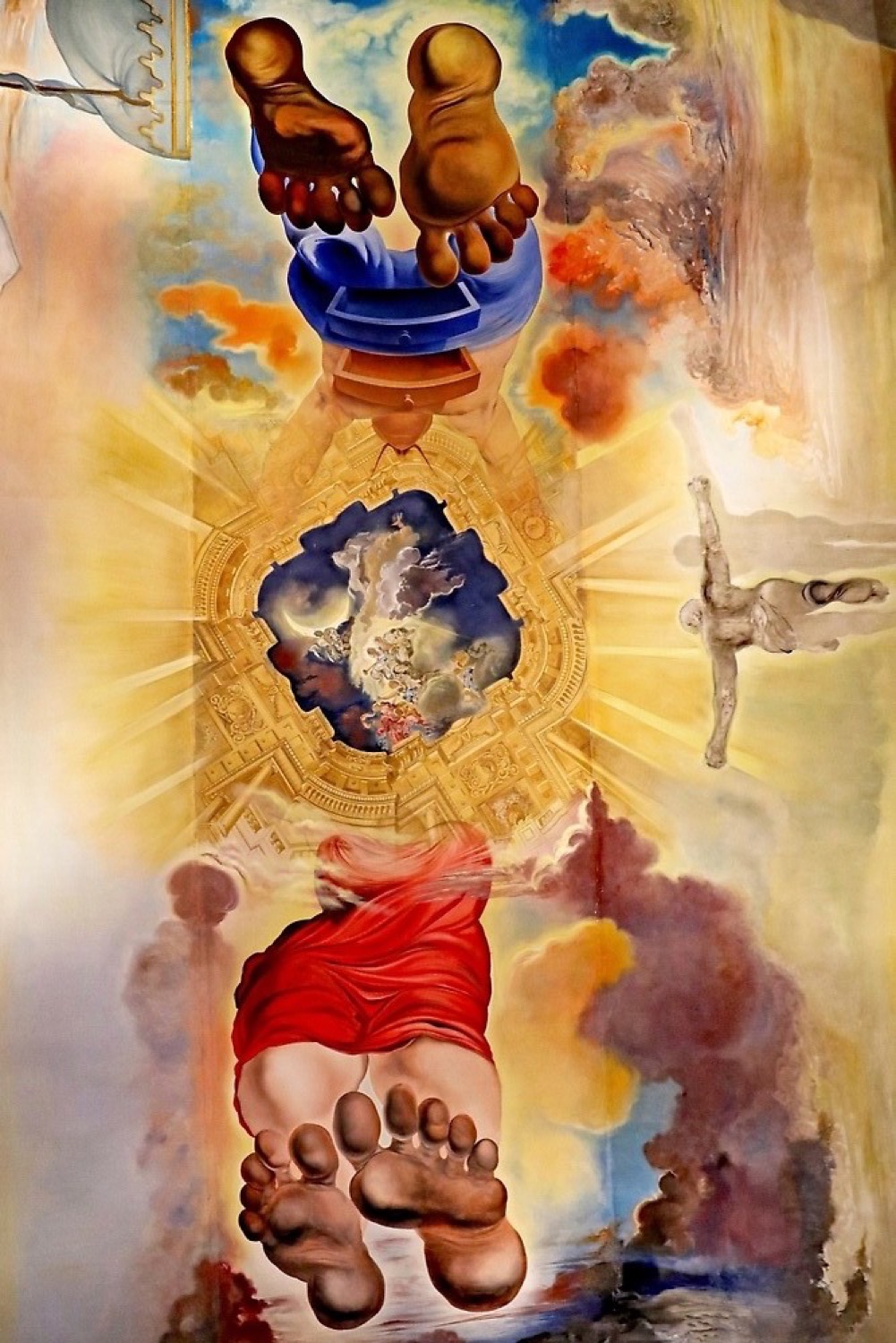
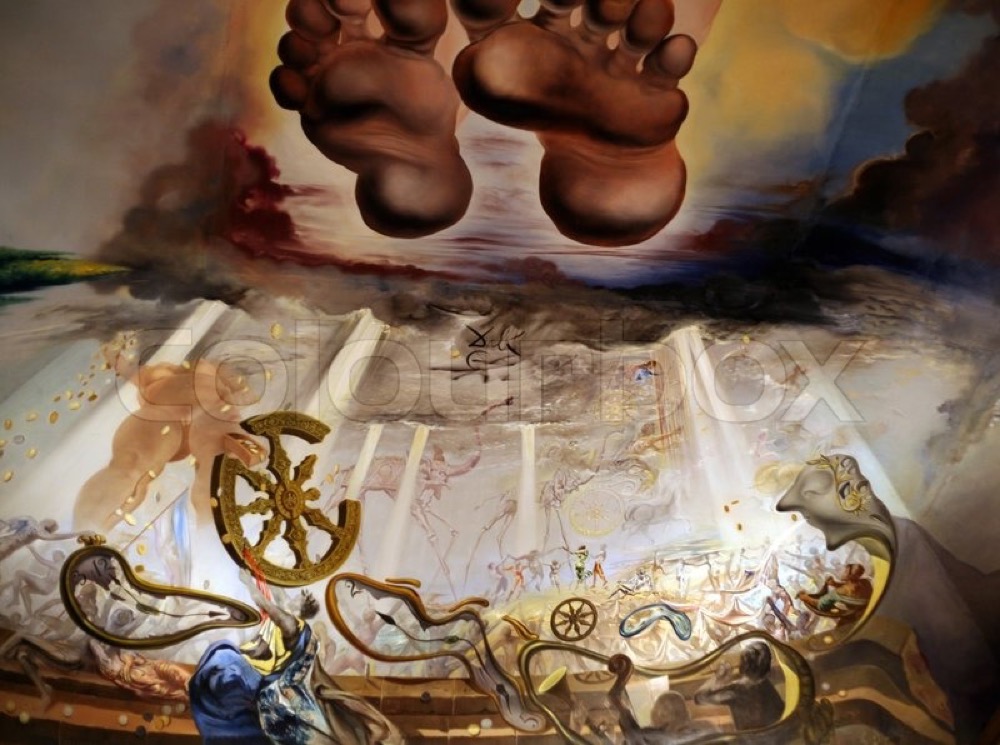
Dalí painted a number of works involving a forced perspective, for example in 1951 he painted "Christ of Saint John of the Cross" (shown below).

It would appear that during his long stay in America he managed to get Russell M. Saunders, a stuntman working for Warner Bros., to do a photo shoot. He was then able to use these photographs as a model. What he had were large photographs in a foreshortened crucified position, with head lowered. The odd thing was that Dalí had to ask a friend surveyor to draw the cross adapted to the perspective and the size of the model in the photographs. The challenge was to determine the vanishing point as seen in the photographs and translate that to the cross. The result above has been called by some experts "vulgar", but personally I think it's fantastic.
When the painting was exhibited, the Museum of Glasgow paid over the odd's to buy not only the painting but also the intellectual property, and it's been making them money ever since.
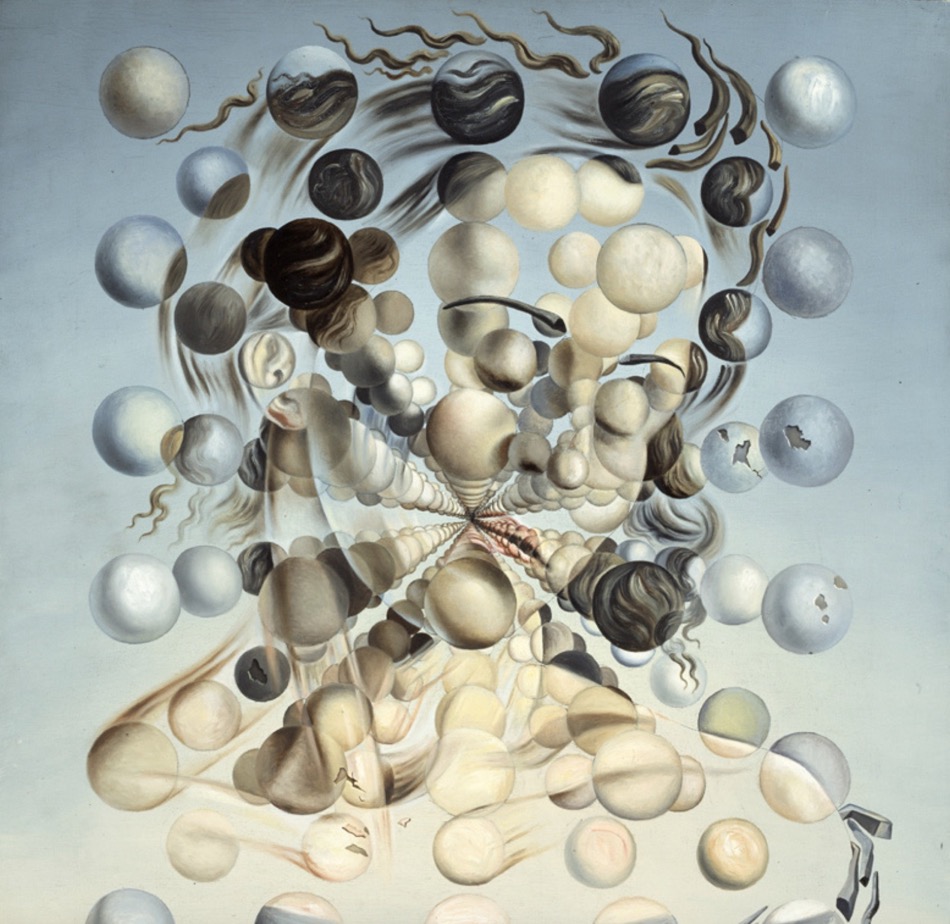
A bit hidden in a side room is one of the most iconic and representative works of Dalí's nuclear-mysticism period. It "Gala Placidia" (often also called "Galatea of the Spheres"), where Gala's face is made up of spheres, which according to Dalí, were subatomic particles. I presume that he was making a comparison between Gala and Galla Placidia, who was a major force in Roman politics in the 5th century AD.
Dalí's "The Mystical Manifesto" was published in 1951, although he had been increasingly adopting that viewpoint from the late 1940's. He had become famous, more so in America with a Times magazine front cover and a MOMA exhibition. As he became more popular so his importance to other artist diminished. He had already been thrown out of the Surrealist movement in 1939, but in many summary documents he is still mistakenly classed as a "surrealist painter" (although Dalí always said "The difference between the Surrealists and me, is that I am a Surrealist"). In the "The Mystical Manifesto" Dalí tried to combine Catholicism and Nuclear (the atomic bomb). His starting point was "My surrealist glory was worthless. I must incorporate surrealism in tradition. My imagination must become classic again". He picked up on nuclear physics and crafted what he called a "nuclear mysticism", thus justifying his belief in God but at the same time his lack of faith. At the time abstract expressionism was on the rise, and few had time for religious themes or classical techniques and composition. After his stay in America, Dalí returned with Gala to Port Lligat, and declared "I realised that I was destined to become the saviour of modern art. I became a saint". And not unsurprisingly he also declared Gala the Virgin Mary, e.g. as in "The Madonna of Port Lligat". In "Leda Atomica" Gala became the goddess of metaphysics. For the first time Dalí created the "floating space" motif and claimed "I have succeeded in give space substance". Many consider "Christ of Saint John of the Cross" to be Dalí's most significant work from this period.
As Dalí returned to "classicism" he wrote "Today's young painters believe in nothing. It is only normal for someone who believes in nothing to end up painting practically nothing, which is the case in the whole of modern art, including the abstract, aesthetic and academic varieties". He felt that contemporary painters were non-figurative, non-objective and non-expressive, and ended up painting nothing.
In 1986, approaching the end of his life, Dalí wrote, …
"I have always said I am a very bad painter, because I am too intelligent to be a good painter.
To be a good painter you have got to be a bit stupid.
With the exception of Velazquez, who is a genius and whose talent surpasses the art of painting.
And to life I owe everything because the day that Dalí paints a picture as good as Velazquez, Vermeer or Raphael, or music like Mozart, the next week he will die.
So I prefer to paint bad pictures and live longer".
It's rare that a museum visit invites one to make some personal comments, but here goes…
Let's start by noting the Sigmund Freud actually wrote about Dalí "We are talking about someone with serious psychological problems". Dalí almost admitted the same when he wrote, "There is only one difference between a madman and me. The madman thinks he is sane. I know I am mad". Mind you he had previously written "There is only one different between a madman and me. I am not mad". So take your pick.
Dalí is known all over the world for his painting of melting clocks ("time is tired", "time is relative"), a style now known as his "paranoiac method". Some people called him eccentric, others a paranoid lunatic, but I personally could understand his desire to create "handmade colour photography of concrete irrationality". How else would you define his creative process? You must remember that quiet early in his life he adopted a new aesthetic theory ("anti-artistic", in his own words), which meant to look at things through the eyes of a Zeiss camera lens, that is, machine-like. The result was an almost perfect draftsman-like skill for fine detail, and an almost excessive realism. Picasso called him "… the last of the great Renaissance painters". His classical technique and use of colour is one of the things that I most appreciate in his work, even if more than once I could not understand how he was describing what he had done. Still it usually sounded great. I also tend to agree with him when he noted that modern art has not kept up with the incredible progress made in science and technology, and at the same time it appears to have also become spiritually poorer than in the past.
As a last comment: when once interviewed on an American television show, Dalí referred to himself in the third person, proclaiming "Dalí is immortal and will not die". Just maybe, with this museum, he is right.
A few references
James Thrall Soby, "Salvador Dalí: paintings, drawings, prints"
Carme Ruiz González, "The Largest Surrealist Object in the World"
Masa Hunijer, "The Last Phase of Salvador Dalí - From the 1940s Until the End"
Robert Descharnes and Gilles Néret, "Salvador Dalí"